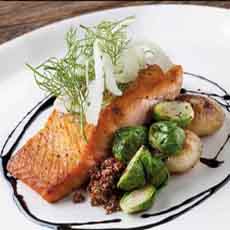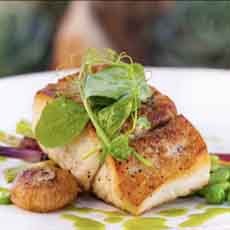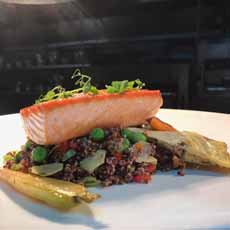|
If you’re accustomed to serving your dinner protein with one vegetable and a starch (potato, noodles, rice)—or veg and a side salad—here’s a tip on “diversification.”
It was inspired by this dish from Bluewater Grill, with several locations in California and one in Phoenix.
Their chefs know that serving multiple items generates more excitement. That’s why buffets are so popular.
YOU CAN DO THE SAME
Just a bit of planning enables you to easily pair your protein with two cooked vegetables, a raw vegetable, and a grain or legume/pulse (the difference is below).
Put together your plate with:
Cooked vegetables (in the photo, Brussels sprouts and cipollini onions; or anything you like, including baby potatoes)
Grains red quinoa in the photo (or rice, especially whole grain; (wheatberries, etc.; vary with other starches like noodles and potatoes).
Legumes or pulses (see the list below).
Raw vegetables as garnish (shaved fennel with fresh dill [photo #1], carrot curls, diced tomato, radicchio julienne, red bell pepper dice, etc.). Or, add a fourth item on the side, such as halved/marinated cherry tomatoes or crudités. Whatever you choose, try to add color.
No sauce is needed, but you can swirl balsamic glaze [photo #1], or dot the plate with pesto, flavored olive oil (basil oil in photo #2) or red bell pepper purée.
Voilá, a healthful, colorful dinner.
Serve with an optional salad:
On a side plate.
As a first course.
After the main course, as the French do. You can add an ounce of cheese to the plate, as the French do, too.
THE DIFFERENCE BETWEEN LEGUMES & PULSES
Both legumes and pulses are the edible seeds of plants in the pea family (Leguminosae), a class of vegetables that includes beans, peas and lentils.
Pulses are a subcategory of legumes. The difference is that legumes are sold fresh, and pulses are grown and harvested to be sold dried. The same product can be sold fresh (legume) or dried (pulse).
The term “legume” refers to any plant whose fruit is enclosed in a pod.
Legumes are a vast family of plants: more than 600 genera and 13,000 species (including chickpeas, peanuts and soybeans.
|
|

[1]Salmon with red quinoa, Brussels sprouts and cipollini onions, topped with shaved fennel and dill.

[2] Salmon with a different set of garnishes: purple asparagus, spring peas, cipollini onions, topped with lightly dressed pea leaves and shoots, plus droplets of basil olive oil (photos #1 and #2 courtesy Bluewater Grill).

[3] Salmon on a bed of grains (here, red quinoa) with baby carrots, green peas and baby artichokes, topped with pea shoots (it’s fresh pea season) (photo courtesy Charlie Palmer Steak).
|





